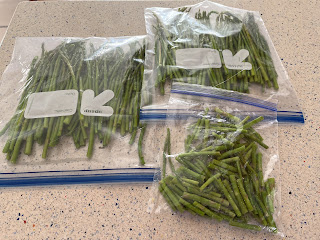I put pizza on my meal plan when I used to have every other Saturday off. Then schedules changed. The other vegetarian options I had took even longer, so I decided to experiment with a slow-rise dough.
Slow-rise, or retarded, dough is not the same thing as sourdough. It is not left out to sour and develop tang, but kept refrigerated for no longer than 36 hours, preferably 18-24. It uses less yeast than a regular dough, less than half. The advantage is more time for the glutens to form in a relaxed location, without frequent pounding and reshaping. The active work time does not change; you just get to stretch it out to fit your schedule.
For the most part, this recipe is going to look familiar. Same basic ingredients, in almost the usual proportions. Same general way to mix and knead. It's from when you start the first rise that it gets a little hinky. I admit, I was crossing my fingers these didn't turn into giant slabs of hardtack with pizza toppings on them.
The taste was fine and the texture was what you would expect out of a pizza. Total time savings on the day was about 20 minutes. Sure, that's 20 minutes earlier than I would have eaten if I had done it all in one go, but it wasn't the 45 minute dinner I had hoped to make.
1 C 100ºF water
3/4 tsp yeast
1 tsp honey or sugar
2 tsp olive oil
about 3 C flour
1 tsp kosher salt
1. Stir yeast, honey, and oil into the water and let sit until foamy. Since the first rise is going to be in the fridge, it is very important that the yeast be activated first.
2. In stand mixer with the paddle, beat water into 1 C flour. I was making this with part wheat flour, and started with that. There are also chia seeds in the dough. You could add dried herbs if you'd like. Beat into a batter, about 2 minutes. Add another cup of flour and the salt and beat another 2 minutes, into a thick, stringy batter.
3. Pour dough onto a floured work surface and knead until smooth, about 5 minutes, adding in just enough flour to prevent sticking. Form into a ball and turn over in a greased bowl to coat all sides. Cover bowl with plastic wrap to prevent drying and refrigerate overnight, 12-24 hours.
4. When ready to make the pizza, let the bowl sit on the counter first for an hour to come partway up to room temperature. This was when I realized I wasn't saving any time by doing it this way. The dough had almost doubled in the fridge over about 20 hours.
5. Punch down dough and turn out onto a lightly floured work surface. Divide into however many pizzas you plan to make, from 4 individual to 1 extra large, and round up into balls. Allow dough to rest 10-15 minutes.
6. Press out dough balls into rounds, and use a rolling pin if necessary to achieve desired thickness. Place on parchment or cornmeal lined baking sheet, or a baking stone. Spread sauce on the pizzas, then let rise about 30 minutes in a warm place. Preheat oven to 375º.
7. Top pizzas and bake about 20 minutes, until crust is baked. Allow to cool 5 minutes so no one burns their mouths, then cut and serve.
Difficulty rating :-0






































